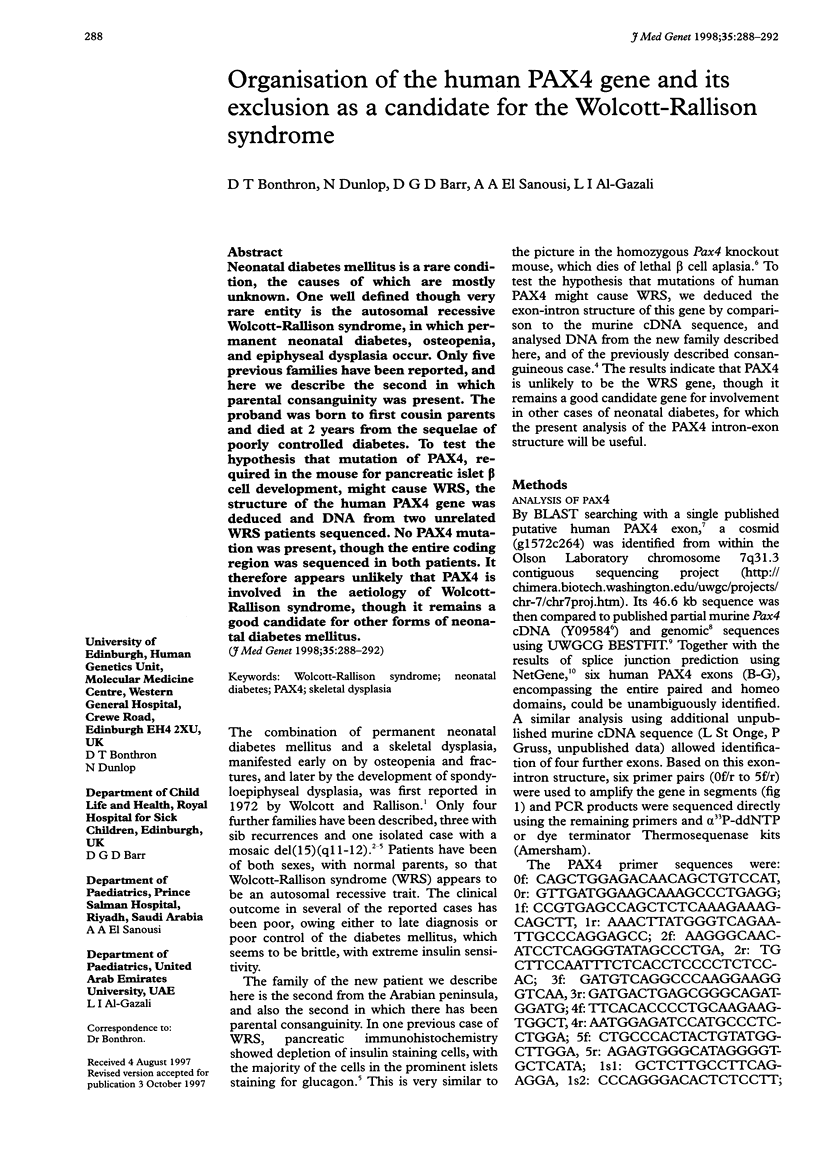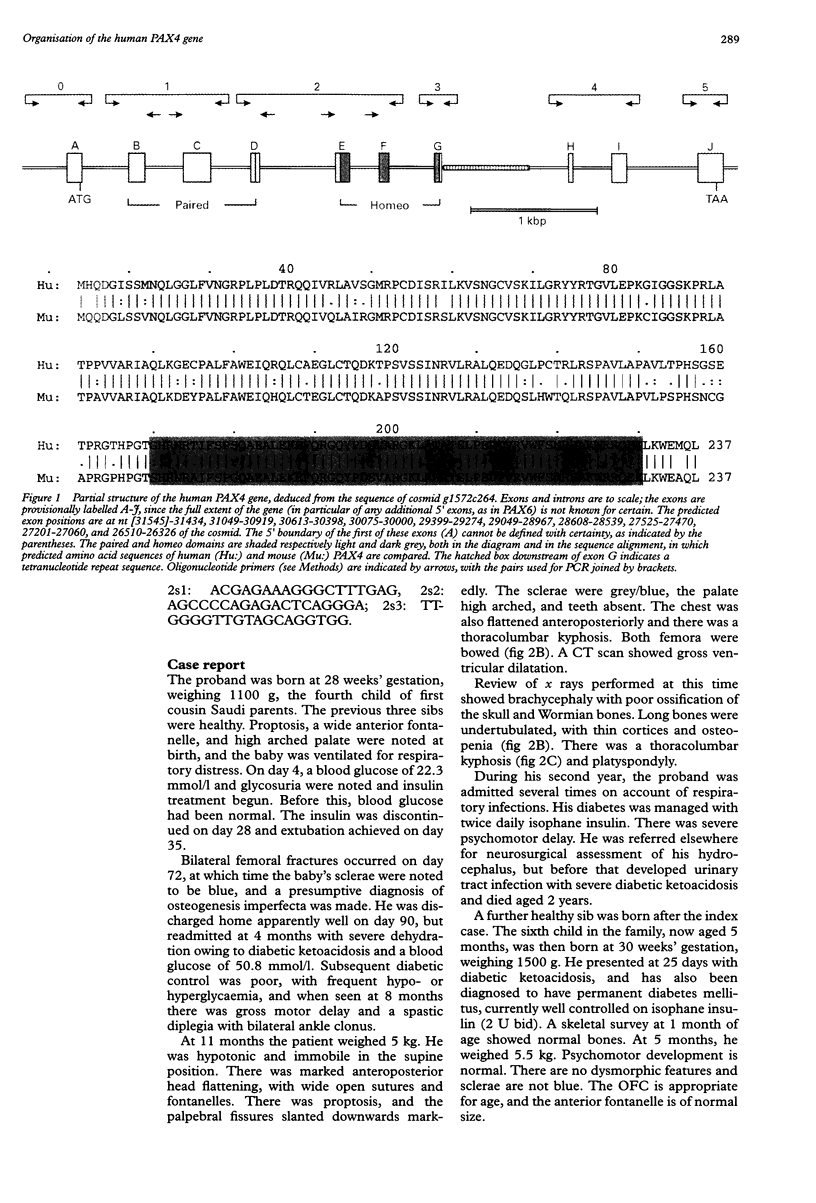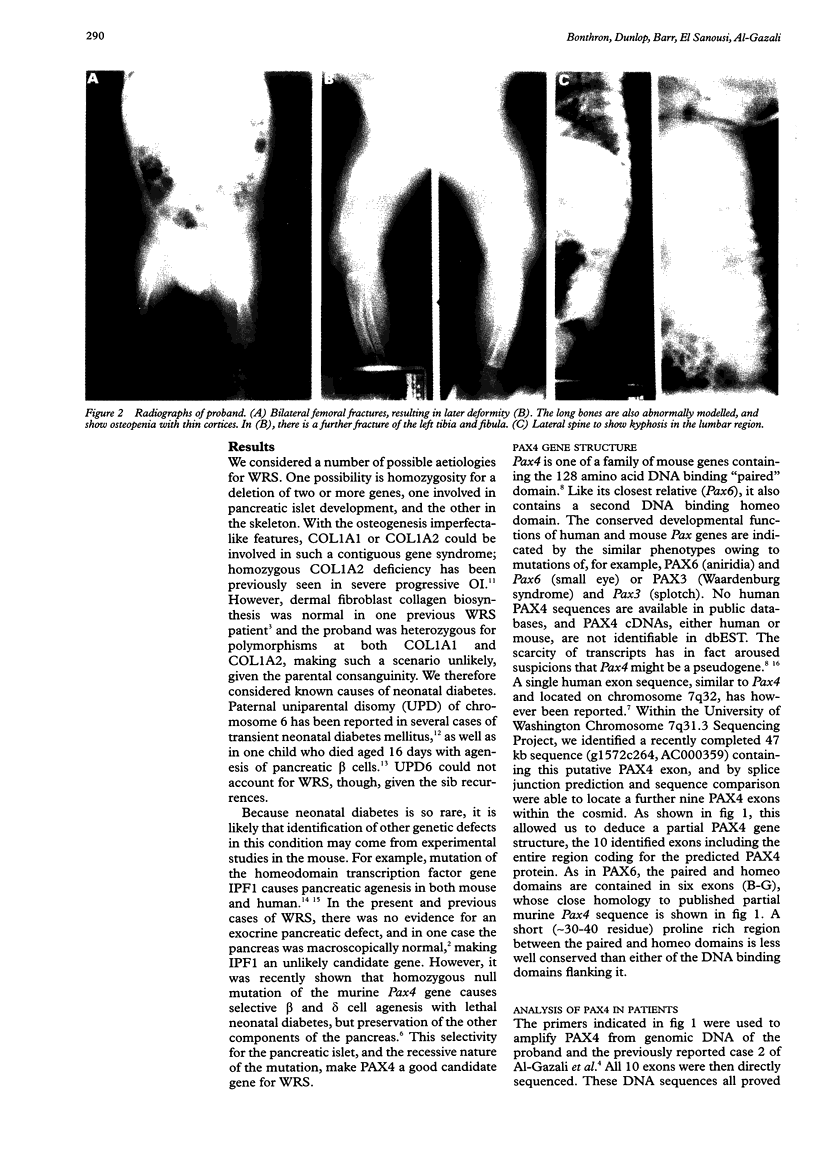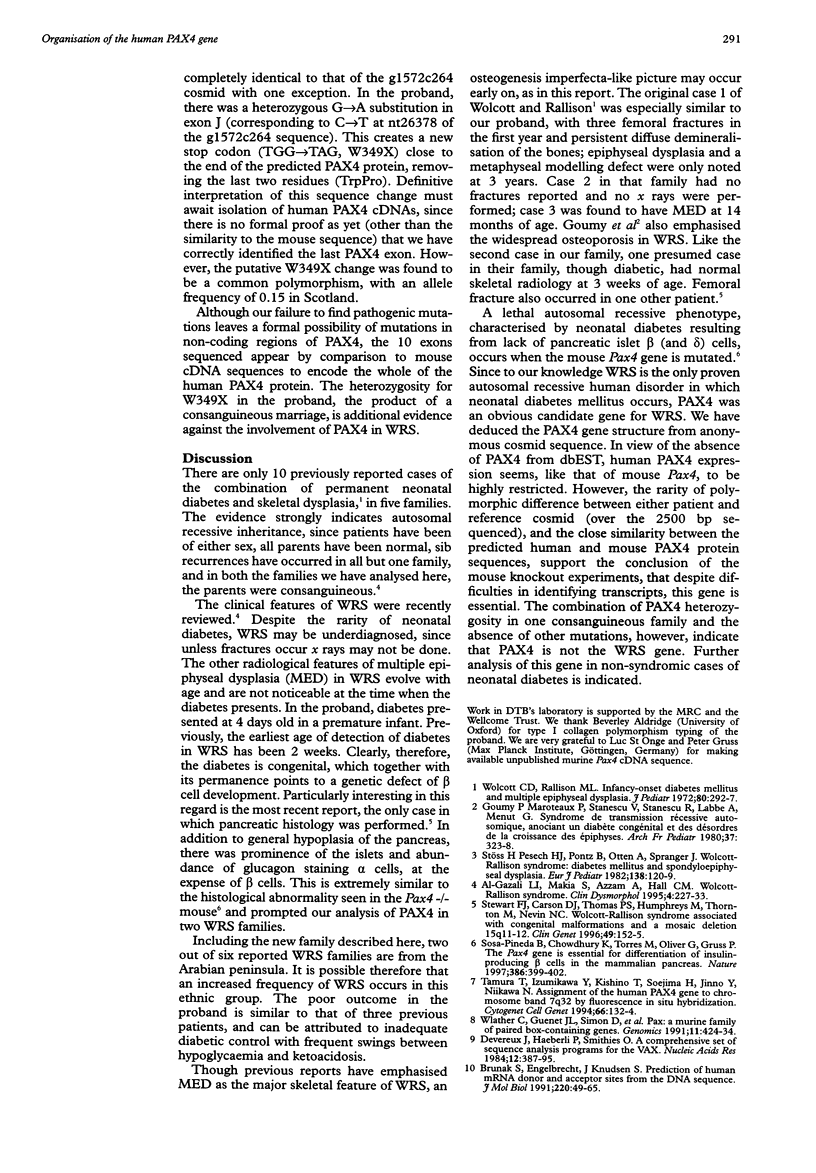Abstract
Neonatal diabetes mellitus is a rare condition, the causes of which are mostly unknown. One well defined though very rare entity is the autosomal recessive Wolcott-Rallison syndrome, in which permanent neonatal diabetes, osteopenia, and epiphyseal dysplasia occur. Only five previous families have been reported, and here we describe the second in which parental consanguinity was present. The proband was born to first cousin parents and died at 2 years from the sequelae of poorly controlled diabetes. To test the hypothesis that mutation of PAX4, required in the mouse for pancreatic islet beta cell development, might cause WRS, the structure of the human PAX4 gene was deduced and DNA from two unrelated WRS patients sequenced. No PAX4 mutation was present, though the entire coding region was sequenced in both patients. It therefore appears unlikely that PAX4 is involved in the aetiology of Wolcott-Rallison syndrome, though it remains a good candidate for other forms of neonatal diabetes mellitus.
Full text
PDF




Images in this article
Selected References
These references are in PubMed. This may not be the complete list of references from this article.
- Abramowicz M. J., Andrien M., Dupont E., Dorchy H., Parma J., Duprez L., Ledley F. D., Courtens W., Vamos E. Isodisomy of chromosome 6 in a newborn with methylmalonic acidemia and agenesis of pancreatic beta cells causing diabetes mellitus. J Clin Invest. 1994 Jul;94(1):418–421. doi: 10.1172/JCI117339. [DOI] [PMC free article] [PubMed] [Google Scholar]
- Brunak S., Engelbrecht J., Knudsen S. Prediction of human mRNA donor and acceptor sites from the DNA sequence. J Mol Biol. 1991 Jul 5;220(1):49–65. doi: 10.1016/0022-2836(91)90380-o. [DOI] [PubMed] [Google Scholar]
- Devereux J., Haeberli P., Smithies O. A comprehensive set of sequence analysis programs for the VAX. Nucleic Acids Res. 1984 Jan 11;12(1 Pt 1):387–395. doi: 10.1093/nar/12.1part1.387. [DOI] [PMC free article] [PubMed] [Google Scholar]
- Goumy P., Maroteaux P., Stanescu V., Stanescu R., Labbe A., Menut G. Syndrome de transmission récessive autosomique, associant un diabète congénital et des désordres de la croissance des épiphyses. Arch Fr Pediatr. 1980 May;37(5):323–328. [PubMed] [Google Scholar]
- Jonsson J., Carlsson L., Edlund T., Edlund H. Insulin-promoter-factor 1 is required for pancreas development in mice. Nature. 1994 Oct 13;371(6498):606–609. doi: 10.1038/371606a0. [DOI] [PubMed] [Google Scholar]
- Nicholls A. C., Osse G., Schloon H. G., Lenard H. G., Deak S., Myers J. C., Prockop D. J., Weigel W. R., Fryer P., Pope F. M. The clinical features of homozygous alpha 2(I) collagen deficient osteogenesis imperfecta. J Med Genet. 1984 Aug;21(4):257–262. doi: 10.1136/jmg.21.4.257. [DOI] [PMC free article] [PubMed] [Google Scholar]
- Sosa-Pineda B., Chowdhury K., Torres M., Oliver G., Gruss P. The Pax4 gene is essential for differentiation of insulin-producing beta cells in the mammalian pancreas. Nature. 1997 Mar 27;386(6623):399–402. doi: 10.1038/386399a0. [DOI] [PubMed] [Google Scholar]
- Stewart F. J., Carson D. J., Thomas P. S., Humphreys M., Thornton C., Nevin N. C. Wolcott-Rallison syndrome associated with congenital malformations and a mosaic deletion 15q 11-12. Clin Genet. 1996 Mar;49(3):152–155. doi: 10.1111/j.1399-0004.1996.tb03275.x. [DOI] [PubMed] [Google Scholar]
- Stoffers D. A., Zinkin N. T., Stanojevic V., Clarke W. L., Habener J. F. Pancreatic agenesis attributable to a single nucleotide deletion in the human IPF1 gene coding sequence. Nat Genet. 1997 Jan;15(1):106–110. doi: 10.1038/ng0197-106. [DOI] [PubMed] [Google Scholar]
- Stöss H., Pesch H. J., Pontz B., Otten A., Spranger J. Wolcott-Rallison syndrome: diabetes mellitus and spondyloepiphyseal dysplasia. Eur J Pediatr. 1982 Mar;138(2):120–129. doi: 10.1007/BF00441137. [DOI] [PubMed] [Google Scholar]
- Sun H., Rodin A., Zhou Y., Dickinson D. P., Harper D. E., Hewett-Emmett D., Li W. H. Evolution of paired domains: isolation and sequencing of jellyfish and hydra Pax genes related to Pax-5 and Pax-6. Proc Natl Acad Sci U S A. 1997 May 13;94(10):5156–5161. doi: 10.1073/pnas.94.10.5156. [DOI] [PMC free article] [PubMed] [Google Scholar]
- Tamura T., Izumikawa Y., Kishino T., Soejima H., Jinno Y., Niikawa N. Assignment of the human PAX4 gene to chromosome band 7q32 by fluorescence in situ hybridization. Cytogenet Cell Genet. 1994;66(2):132–134. doi: 10.1159/000133684. [DOI] [PubMed] [Google Scholar]
- Temple I. K., Gardner R. J., Robinson D. O., Kibirige M. S., Ferguson A. W., Baum J. D., Barber J. C., James R. S., Shield J. P. Further evidence for an imprinted gene for neonatal diabetes localised to chromosome 6q22-q23. Hum Mol Genet. 1996 Aug;5(8):1117–1121. doi: 10.1093/hmg/5.8.1117. [DOI] [PubMed] [Google Scholar]
- Walther C., Guenet J. L., Simon D., Deutsch U., Jostes B., Goulding M. D., Plachov D., Balling R., Gruss P. Pax: a murine multigene family of paired box-containing genes. Genomics. 1991 Oct;11(2):424–434. doi: 10.1016/0888-7543(91)90151-4. [DOI] [PubMed] [Google Scholar]
- Wolcott C. D., Rallison M. L. Infancy-onset diabetes mellitus and multiple epiphyseal dysplasia. J Pediatr. 1972 Feb;80(2):292–297. doi: 10.1016/s0022-3476(72)80596-1. [DOI] [PubMed] [Google Scholar]
- al-Gazali L. I., Makia S., Azzam A., Hall C. M. Wolcott-Rallison syndrome. Clin Dysmorphol. 1995 Jul;4(3):227–233. [PubMed] [Google Scholar]




